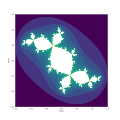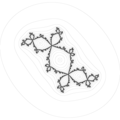Douady rabbit
The Douady rabbit is any of various particular filled Julia sets associated with the parameter near the center period 3 buds of Mandelbrot set for complex quadratic map.
-
colors show iterations
-
Gray levels indicate the speed of convergence to infinity or to the attractive cycle
-
boundarties of level sets
-
fat rabbit
-
with spine
-
external rays landing on fixed point .
-
Perturbated Rabbit [1]
-
Perturbated rabbit zoom
Name
Douady's rabbit or the Douady rabbit is named for the French mathematician Adrien Douady.[2]
The fat rabbit or chubby rabbit has c at the root of 1/3-limb of the Mandelbrot set. It has a parabolic fixed point with 3 petals.[3]
Forms of the complex quadratic map
There are two common forms for the complex quadratic map . The first, also called the complex logistic map, is written as
where is a complex variable and is a complex parameter. The second common form is
Here is a complex variable and is a complex parameter. The variables and are related by the equation
and the parameters and are related by the equations
Note that is invariant under the substitution .
Mandelbrot and filled Julia sets
There are two planes associated with . One of these, the (or ) plane, will be called the mapping plane, since sends this plane into itself. The other, the (or ) plane, will be called the control plane.
The nature of what happens in the mapping plane under repeated application of depends on where (or ) is in the control plane. The filled Julia set consists of all points in the mapping plane whose images remain bounded under indefinitely repeated applications of . The Mandelbrot set consists of those points in the control plane such that the associated filled Julia set in the mapping plane is connected.
Figure 1 shows the Mandelbrot set when is the control parameter, and Figure 2 shows the Mandelbrot set when is the control parameter. Since and are affine transformations of one another (a linear transformation plus a translation), the filled Julia sets look much the same in either the or planes.
The Douady rabbit




The Douady rabbit is most easily described in terms of the Mandelbrot set as shown in Figure 1 (above). In this figure, the Mandelbrot set, at least when viewed from a distance, appears as two back-to-back unit discs with sprouts. Consider the sprouts at the one- and five-o'clock positions on the right disk or the sprouts at the seven- and eleven-o'clock positions on the left disk. When is within one of these four sprouts, the associated filled Julia set in the mapping plane is a Douady rabbit. For these values of , it can be shown that has and one other point as unstable (repelling) fixed points, and as an attracting fixed point. Moreover, the map has three attracting fixed points. Douady's rabbit consists of the three attracting fixed points , , and and their basins of attraction.
For example, Figure 3 shows Douady's rabbit in the plane when , a point in the five-o'clock sprout of the right disk. For this value of , the map has the repelling fixed points and . The three attracting fixed points of (also called period-three fixed points) have the locations
The red, green, and yellow points lie in the basins , , and of , respectively. The white points lie in the basin of .
The action of on these fixed points is given by the relations
Corresponding to these relations there are the results
Note the marvelous fractal structure at the basin boundaries.

As a second example, Figure 4 shows a Douady rabbit when , a point in the eleven-o'clock sprout on the left disk. (As noted earlier, is invariant under this transformation.) The rabbit now sits more symmetrically on the page. The period-three fixed points are located at
The repelling fixed points of itself are located at and . The three major lobes on the left, which contain the period-three fixed points ,, and , meet at the fixed point , and their counterparts on the right meet at the point . It can be shown that the effect of on points near the origin consists of a counterclockwise rotation about the origin of , or very nearly , followed by scaling (dilation) by a factor of .

See also
References
- ^ Recent Research Papers (Only since 1999) Robert L. Devaney: Rabbits, Basilicas, and Other Julia Sets Wrapped in Sierpinski Carpets
- ^ "Julia Sets and the Mandelbrot Set Archived 2016-08-07 at the Wayback Machine", Math.Bard.edu.
- ^ Note on dynamically stable perturbations of parabolics by Tomoki Kawahira Archived October 2, 2006, at the Wayback Machine
- ^ Thurston equivalence of topological polynomials by Laurent Bartholdi, Volodymyr Nekrashevych
External links
- Weisstein, Eric W. "Douady Rabbit Fractal". MathWorld.
- Dragt, A. http://www.physics.umd.edu/dsat/dsatliemethods.html. Lie Methods for Nonlinear Dynamics with Applications to Accelerator Physics.
This article incorporates material from Douady Rabbit on PlanetMath, which is licensed under the Creative Commons Attribution/Share-Alike License.








![Perturbated Rabbit [1]](http://upload.wikimedia.org/wikipedia/commons/thumb/d/db/Perturbated_Rabbit_Julia_set.png/120px-Perturbated_Rabbit_Julia_set.png)
















































